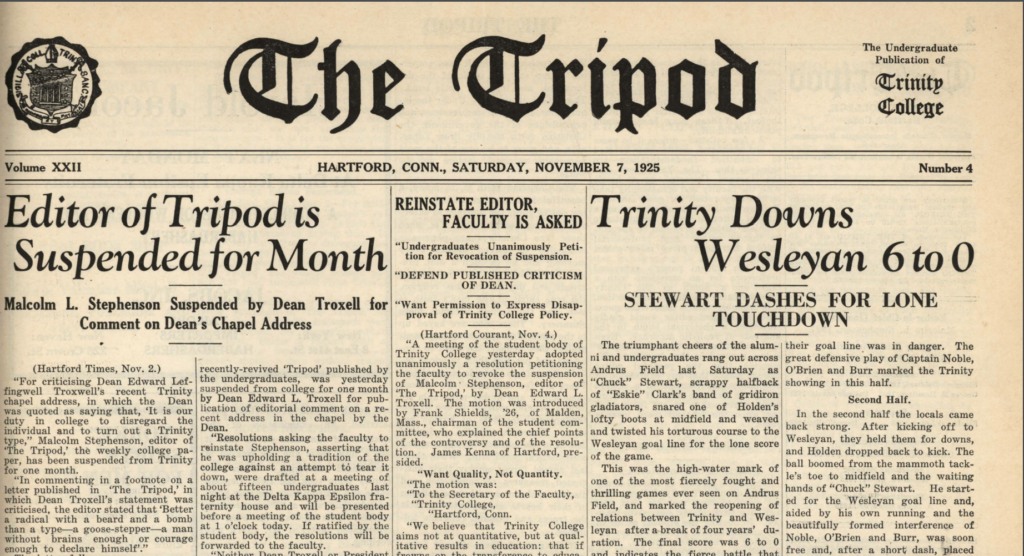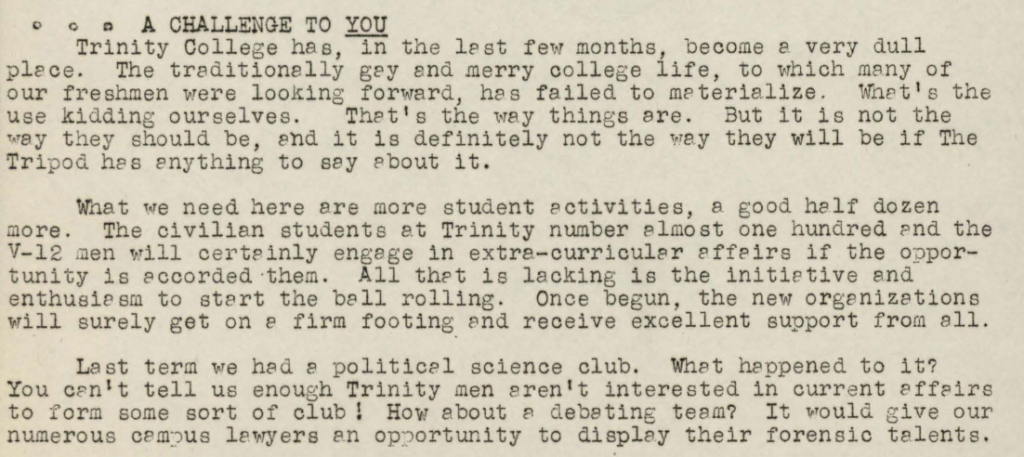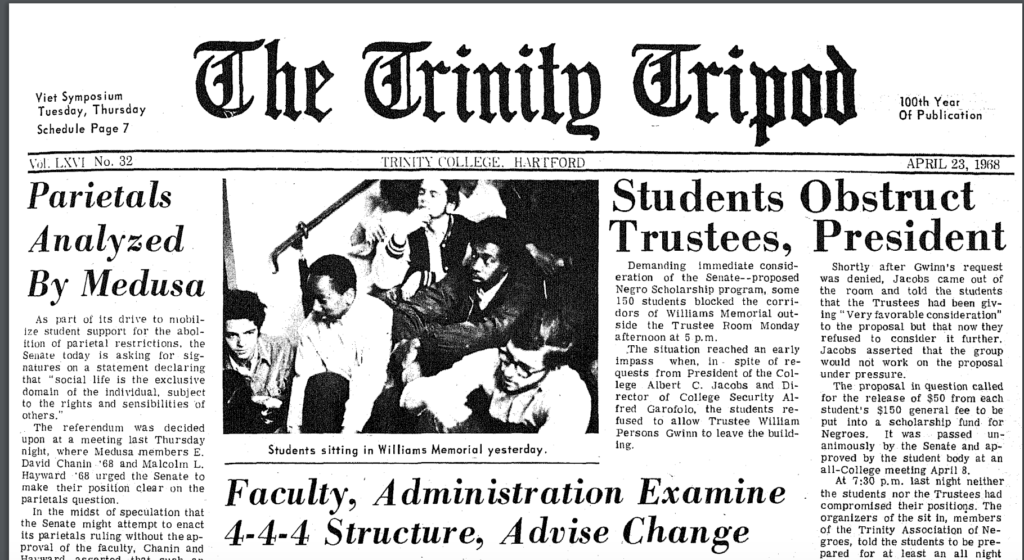Gillian Reinhard ’20
Special to the Trinity Tripod
In comparison to its peer student newspapers, The Trinity Tripod is relatively new, being one of just three NESCAC newspapers to be founded in the twentieth century—the other two being The (Connecticut) College Voice (1916) and The Middlebury Campus (1905). In contrast, other NESCAC newspapers were founded in the late nineteenth century, such as The Bowdoin Orient (1871) and The Wesleyan Argus (1868). One notable exception is at Hamilton College, where the student newspaper dates back to 1847.
Unlike at other institutions, however, the Tripod, founded in 1904, was not the College’s first student publication nor its first student newspaper. In 1868 (a date perhaps more in line with its peers), The Trinity Tablet became Trinity’s first publication, even preceding the yearbook, The Trinity Ivy (1876). As described in the Trinity College Digital Archives, the Tablet was an eclectic mix of content—part newspaper, part alumni magazine, and part art publication.
From 1904 to 1908, the Tripod and the Tablet coexisted, until The Trinity Tablet ceased publication in June 1908. Since then, there has been talk throughout the decades of reviving the publication in some form, but little has manifested.
In comparison to the Tripod, the Tablet offered a view toward art, culture, and literature, with notable features including student-written short stories and Trinity reminisces offered by alumni. In contrast, the Tripod served as a publication geared toward students and alumni covering announcements and sports, a new part of undergraduate life in the early twentieth century.
The Tripod arose at a time of change in American higher education following the Civil Wars. In The History of Trinity College, Glenn Weaver attributes this shift at the College, in part, to Flavel Sweeten Luther, who became president of Trinity in 1905. A former mathematics professor at the College and a close friend of United States President Theodore Roosevelt (Luther is responsible for the famous Roosevelt plaque on the quad), President Luther brought a sense of positivity and progressivism to Trinity and was generally supported by Tripod student editorials at the time. As noted in Weaver’s history, Luther was known for exclaiming “Now, then—Trinity!” This became the Tripod’s first motto and remains in use today.
In its early years, the Tripod seemed to receive some criticism from alumni who subscribed to the paper. Alumnus Robert A. Benton complained in a letter to the editor that the publication focused too heavily on athletics and lacked, “smooth prose or polished verse, if ever any undergraduate is moved to experiment with the English language.” Indeed, the early years of the Tripod (in the form of a four-page, twice-weekly paper) centered around advertisements and the football games of the then-called Hilltoppers (“Bantam” did not arise as the widely accepted mascot in issues of the Tripod until later in the twentieth century).
Eventually, however, the often-submitted letters to the editor from alumni and students, in conversation with Tripod staff editorials, changed the dynamic of the paper. The paper became more and more of a window into student life at the College. For example, in the late 1910s, the Tripod criticized the creation of a Trinity Socialist Society and argued that the club should not be allowed to exist. A Trinity alumnus and former Tripod editor William A. Bird ’12 wrote in to express his disappointment with the paper for taking the stance. Early issues of the Tripod also track the contentious issue of compulsory chapel attendance at Trinity and remained a topic of debate in the Tripod until its abolition in the 1960s. In 1917, the paper switched to a once-weekly format, published on Tuesdays, which is still followed today.
Issues of the Tripod from the 1920s reveal a difficult time for recruiting contributors and forging a sense of identity for the paper. In 1924, a new editor-in-chief, Charles E. Cunningham ’24, promised a renewed commitment to creating a quality student newspaper and finding a dedicated staff of student writers. Cunningham only lasted in the position of editor-in-chief for a few months. A 1926 editorial titled “What’s Wrong with Trinity?” highlighted a lack of student involvement in all organizations on campus. Throughout the 1920s, the staff was often composed of just one student writing each week. In 1925, only two issues of the Tripod managed to be published due to a lack of student interest. Despite a small staff, Tripod editorials became increasingly critical of the College and its administration, which shifted its focus away from an initial purpose as an alumni magazine with an exclusively positive representation of the College.

Tensions between the Trinity administration and the Tripod staff reached a boiling point in 1925, when editor-in-chief Malcolm L. Stephenson ’27 was suspended from Trinity for writing an editorial critical of a speech delivered by Dean Edward Troxwell. The administration’s decision to expel the student was criticized by the faculty and subsequently was covered in The Hartford Courant, The New York Times, and The Associated Press. In 1926, the Tripod returned with an advisory board that included Dean Troxwell and President Remsen Brinckerhoff Ogilby.

Following the turbulent 1920s, the Tripod enjoyed success as a weekly student newspaper throughout the 1930s and 1940s. This was an exciting time to be a student at Trinity, as evidenced by major changes on campus, including the construction of the Chapel. In 1941, the Tripod published The Trinity Tripe on April Fools’ Day as a satirical special newspaper, a tradition which continues today as the annual Trinity Liepod. The success of the Tripod ended with the beginning of World War II, when many students left Trinity to fight in the war. Tripod editor Stanley Kligfeld attempted to keep the paper running as the United States joined the war effort, but the paper stopped publishing almost entirely between 1943 to 1944. In December of 1944, editor Harry Brand recreated the Tripod as a magazine, but only published a handful of issues. By 1946, editor Tom Gorman reestablished the Tripod as the College’s student newspaper and oversaw a redesign of the paper that included the five sections found in the paper today—news, opinion, features, arts and entertainment, and sports.

Peter Knapp’s Trinity College in the Twentieth Century cites the 1950s as a restless time at the College due to the departure of the popular President George Keith Funston ’34. Knapp also linked growing insecurity about international affairs (such as the Korean War and the Cold War) to increasingly destructive activity in the fraternities. Potentially due in part to a 14% increase in enrollment in 1953, however, the Tripod maintained a regular staff and a critical lens of both fellow students and the administration. The Tripod covered new events such as the creation of what is today the Raether Library, a visit from United States President Dwight D. Eisenhower to receive an honorary doctorate at Commencement in 1954, and a surprise visit from United States President Richard Nixon to attend services at the Chapel.

A Tripod 1964 editorial titled, again, “What’s Wrong with Trinity?” argued that the College lacked student engagement and a sense of identity crisis. 1964 also marked a special issue of the Tripod, celebrating 60 years of the publication.
Trinity history professor and Tripod alumnus Jack Chatfield ’64 reminisced on the history of the newspaper at Trinity during this time in an interview with Tripod editor-in-chief Carver Diserens ’09. Chatfield cited the marked influence of George Will ’62 (of The Washington Post and The Wall Street Journal) and Peter Kilborn ’61 (of The New York Times) as editors of the Tripod.
When nearly all students at Trinity were members of fraternities, Will took an increasingly critical stance on the organizations for their treatment of Jewish and African-American students. In 1961, he argued that students should not join fraternities at all. As recounted by Chatfield, Will’s article inspired batches of the Tripod to be burned by irate students. Throughout the 1960s, editors continued to shift their focus from criticizing the administration to criticizing fellow students on campus—tackling issues such as fraternities (editorial: “Fraternities Must Go,” 1966) and the infamous Medusa Society (editorial: “Don’t Give Students that Power,” 1965).

The Tripod extensively covered the 1968 sit-in at Downes and Williams during a Board of Trustees meeting. 168 students occupied the building for over 30 hours to demand increased scholarship opportunities for African American students. As explained by Kanpp in Trinity College in the Twentieth Century, debate amongst the faculty unfolded in the pages of the Tripod, where some professors lauded the actions of the student protestors while others argued the actions were unnecessary. Additionally, the Tripod gathered student opinion, where some students expressed disapproval with the tactics of the sit-in, whereas other students announced their enthusiastic support for the sit-in.
Part Two of this “History of the Tripod” will cover 1970 to the present day and will be published as the Sunday Feature on November 8.
Gillian Reinhard ’20 is a recent Trinity graduate and a former Tripod editor.
The Tripod graciously welcomes submissions from alumni and alumnae from any class year on any topic related to Trinity College and its affairs, programs, and future. Submissions may be sent directly to tripod@trincoll.edu.










+ There are no comments
Add yours